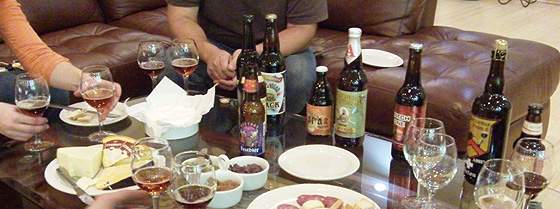
By Julia Burke, Niagara Escarpment Contributor
What happens when winemakers and winery employees get together to hang out during harvest? They drink beer, of course. And since wine people love to talk about “new world” versus “old world,” and since I’m fascinated by the intersections of the wine and beer scenes, I thought I’d throw a little beer tasting party to test the waters.
After a long day of picking cabernet franc I collapsed on the couch with some of my favorite Niagara Escarpment winemakers and winery employees and enjoyed a lineup of five beer styles in their European and American incarnations. I kept categories broad rather than splitting hairs over sub-categories (stouts alone could’ve been an entire separate tasting) to prevent my non-beer-geek friends’ eyes from glazing over.
The obvious choice to kick off this lovely fall evening was Oktoberfest-Märzen, and the beers facing off couldn’t have been more different within the boundaries of the style. Our Yankee choice was Victory Brewing Company’s Festbier, a sweetly malty, low-alcohol, refreshing session beer, while Schlenkerla Rauchbier Märzen of Bamberg, Bavaria was a deliciously smoky, bacon-y, campfire-tastic sipper. All present found the German brew the more interesting and complex of the two, though more suited to sipping with a steak dinner than guzzling at an Oktoberfest party.
We took things up a notch with one of my favorite categories: stouts. Bear Republic Big Bear Black Stout from Sonoma, California was pitted against Mikkeller Beer Geek Breakfast Stout, produced by Norwegian brew gods Nøgne Ø. No contest here – the Mikkeller absolutely rocked everyone’s world with its roasty oatmeal/coffee flavors and soothing drinkability, though one of the tasters was a bit petulant about the marketing (I feel like beer geeks, myself included, tend to use the term “geek” a little more democratically than wine geeks do, so to me the name “Beer Geek Breakfast” just sounds conveniently suited to my demographic, rather like a womens multivitamin or Pirate’s Booty). The Bear Republic was a bit too milk-flavored (“old cafeteria milk,” someone said) and watery by comparison.
The marketing issue is an interesting one that led to a heated discussion when one taster suggested that beer had “more marketing” than wine. It’s a great topic that I hope to tackle in a future post. But this was a night for drinking beer, not arguing brand management.
Barleywines came next, and I was originally going to use Flying Dog Dogtoberfest for my American representative, but it somehow got, ahem, misplaced. Fortunately, one taster brought a growler of Brooklyn Monster Ale, so we had a worthy opponent for the Danish barleywine Amager Batch One. This was a tough call. The Brooklyn was peachy, smooth, caramelly, and well-carbonated, while the Amager was darkly malty, seductive, and complex. Ultimately the Amager has the slight edge for downright lascivious mouthfeel, but the Brooklyn gets props for hiding its extra 2% ABV with elegance. It was great to see a New York beer show so well in this all-star lineup.
When the time came to taste IPAs, I knew the only worthy European rival for what is arguably America’s best beer style would be a Belgian IPA. I wanted to select one I hadn’t tried (no small feat as this is one of my all-time favorite styles), so I picked up Alvinne Caspar Ale, which claims to be “one of the hoppiest beers of Belgium.” I could think of no better example of an American-made IPA than Maharaja, a masterpiece from Avery Brewing Company in Boulder, Colorado. The Caspar didn’t have a chance. Though it was subtle and nicely layered, its skittish hoppiness and weak nose paled in comparison to the Maharaja’s gorgeous, exotic, unearthly spices and fruits. Maharaja was supremely hoppy but perfectly balanced, and all present agreed to its superiority.
What better style to finish off the evening than Belgian Abbey Ale? I pitted North Coast Brother Thelonius against St. Bernardus Pater 6, and the North Coast nearly beat the Bernardus at its own game with well-integrated alcohol and complex malts. Ultimately, the Bernardus was what kept getting passed around, topping the North Coast in the sheer multitude of delicious raisin/date/prune flavors, deep mahogany color, and a length that didn’t quit.
At the end of the evening, the beers to disappear fastest were Amager Batch One Barleywine, Mikkeller Beer Geek Breakfast, and Avery Maharaja – truly outstanding beers that fulfilled the requirements of their style but offered enough complexity to satisfy the discerning palates of wine lovers.
Are the “Old World” and “New World” distinctions useful for beer? The European selections all had deeper color and a more layered complexity, and generally were lower in hops expression and carbonation. When punch-in-the-face hoppy is what you want, though, buy American – we may not have invented the IPA, but we certainly perfected it.
Considering the number of American breweries attempting (and often excelling at) “Old World” styles, and the increasing number of American-inspired beers coming out of Europe. this particular tasting only scratched the surface. Can’t wait to expand this experiment, and the great conversation that accompanied it, into future tastings.
